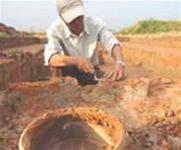Traces of Tran's
Trung Hoa Archaeological Site - one of the two largest palaces of Tran Thien Truong's Palace has just been discovered during archaeological excavations at the field between Tran temple and Thap pagoda (Tuc Mac village - Loc Vuong ward - Thanh Nam Dinh city).
Dense relics
Excavation conducted by Vietnam Institute of Archeology and Nam Dinh Museum in coordination, carried out from November 2006 and is continuing on an area of more than 2,000 m 2 , with about 30 pits. excavation. ' Relics appear dense, the number has reached tens of thousands ', an archaeological expert said.
In particular, in 3 holes of excavation and excavation in the west of Tran temple, there are traces of the architectural relics of Tran Dynasty, such as terracotta drainage system, pillar foundation, floor tiles and bricks. There are engraved Chinese characters ' Vinh Ninh Truong ', decorative materials such as stone stones, smooth stones, lotus nose tiles and dragon's phoenix-shaped leaves . Nearly 10 small squares have been found lined with bricks and tiles, according to Initial conjecture may be a trace of bonsai garden. In addition to construction materials, most of them are made of chinaware and ceramic glaze . In particular, there are some celadon and white glaze bowls with very delicate lotus and peony patterns. All are typical for the Tran dynasty style.
'Second capital'

Relics and architectural traces appear during excavations.(Photo: Labor)
According to history books, from the Tran dynasty began to have a royal regime. The kings were often in their fifties, ceding the throne to the most gifted son, regardless of whether they were chiefs, but the supreme emperor in fact still decided important things, continuing to forge the pair of incumbent kings. . The first kings of the Tran dynasty after ceding the throne to their children returned to rest in his home town of Tuc Mac, so this place was once considered the " second capital" of the Tran Dynasty.
Ie is a land of the Tran dynasty, so since 1239, the king has built a palace here to stay when visiting. During the first resistance war against Nguyen Mong, Linh from National Model Tran Thi Dung brought the entire royal family to evacuate. In the year of Nham Tuat (1262), the Tran dynasty expanded the scale to build the Palace of Thien Truong, with the capital of Tuc Mac. In particular, the two largest palaces are the Trung Quang palace (the royal place to return to the throne) and the Cung Hoa palace (where Tran kings return to adoration). Based on historical books and archaeological excavations, Tran temple area was built on the old foundation of these two most important palaces.
According to an archaeological professor, although the excavation has not yet ended, but with the relics and relics that have appeared, it is surmised that it is probably the Flower Palace. This excavation will provide important information about the appearance of the Heavenly Palace.
Mr. Nguyen Anh Thu - Director of Nam Dinh Museum - said this excavation is part of a conservation master plan project to promote and promote the value of historical and cultural relics in the Tran dynasty in Nam Dinh until the year. 2015 has been approved by the Government. The excavated site is expected to be the site of Dong A Square and some other infrastructure. So, the discovery of this relic has any impact on this construction project?
In response to this question, Dr. Nguyen Xuan Nam - Director of Nam Dinh Department of Culture and Information - affirmed: 'Except for places where there are really strong architectural relics, Nam Dinh Department of Culture and Information will propose to retain, if not Construction projects will still proceed normally '.
- WHO calls for a complete removal of trans fat for 5 years
- Aspirin counteracts the effects of trans fat
- The first cross-sea tunnel connecting Asia-Europe
- Fat milk reduces the risk of type 2 diabetes
- Controversy about sprays erasing all traces of DNA
- Found traces of plankton in the universe
- Giant car traces of prehistoric times
- NASA seeks a portal into another world and traces of aliens in Antarctica
- The oldest traces of human beings.
- Discover the oldest traces of modern Europeans
- Investigating crimes through traces of perspiration
- Belgium discovered traces of an ancient village at a construction site
 Discovered an ancient centipede fossil 99 million years old
Discovered an ancient centipede fossil 99 million years old Discovered bat-like dinosaurs in China
Discovered bat-like dinosaurs in China Discovered a 200-year-old bronze cannon of the coast
Discovered a 200-year-old bronze cannon of the coast Discover 305 million-year-old spider fossils
Discover 305 million-year-old spider fossils